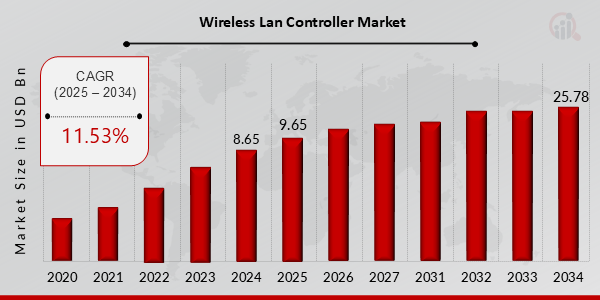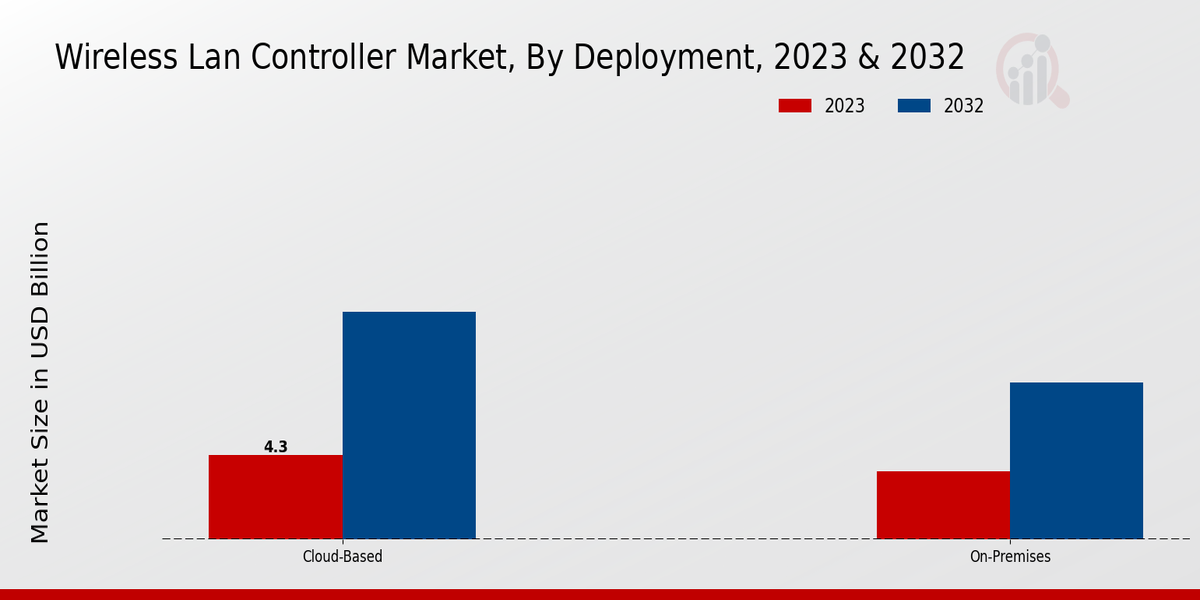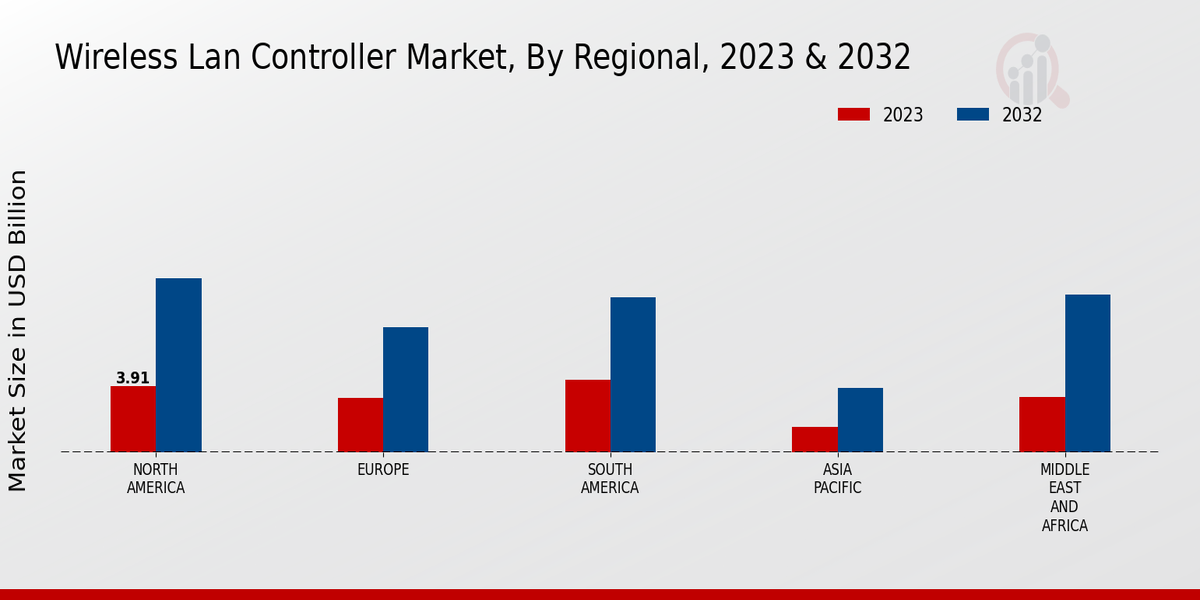Global Wireless LAN Controller Market Overview
Wireless Lan Controller Market Size was estimated at 8.65 (USD Billion) in 2024. The Wireless Lan Controller Market Industry is expected to grow from 9.65 (USD Billion) in 2025 to 25.78 (USD Billion) till 2034, exhibiting a compound annual growth rate (CAGR) of 11.53% during the forecast period (2025 - 2034).
Key Wireless LAN Controller Market Trends Highlighted
The Wireless LAN Controller Market is expected to grow in the years to come. The growing demand for wireless infrastructure, as a fundamental driver of the market, seamless connectivity & cloud-managed solutions and increasing use of IoT devices are some of the reasons contributing to it. Moreover, the rising demand for secure and dependable wireless networks in businesses and public spaces is also aiding in the growth of the market.
There has been a rise in wireless LAN controllers because, due to the increase in remote and hybrid work models, there has been heavy reliance on wireless networks. WiFi technologies have also progressed with new technologies like WiFi 6E, which is faster, has lower latency, and has higher capacity, which will lead to growth opportunities.
The notable trends include the approach towards a hybrid model network comprising fixed and mobile networks with flexible access, the introduction of AI for network management, and software-based network platforms for centralized management of the network. These are the developments that are re-defining the market of Wireless LAN Controllers and giving advantages to how their manufacturers can come up with new innovations.

Source: Primary Research, Secondary Research, MRFR Database and Analyst Review
Wireless LAN Controller Market Drivers
Increasing adoption of Wireless LANs in various sectors
Wireless LANs have been used more frequently in the last few years in different fields such as education, healthcare, hospitality, and retail. There are several causes of such increased usage. The upsurge in the number of mobile devices, the increased popularity of cloud-based applications, and the need for a more flexible and efficient network caused the growth of wireless LAN use. The Wireless LAN Controller Market Industry is expected to grow from USD 6.96 billion in 2023 to USD 18.6 billion by 2032, at a CAGR of 11.53% during the forecast period. The growing usage of Wireless LANs in a number of fields is one of the major causes of such a tendency. One of the key causes of the growth of the Wireless LAN Controller Market is the increase in the number of mobile devices. In recent years, the number of mobile devices has been on the rise. Among them, there are smartphones, tablets, and laptops. There is a tendency for such devices to be used more frequently to access the internet, check email, and use business applications. That is why there is a need for a wireless network that will provide such devices with reliable and high-speed connectivity. Another cause of the growth of the Wireless LAN Controller Market is the increased popularity of cloud-based applications. Such applications are generally software-as-a-service and platform-as-a-service. The applications are connected to the internet and accessed over it. Cloud-based applications do not require users to install and support software on their personal computers. That is why there is a need for Wireless LANs that will provide cloud-based applications with reliable and high-speed connectivity. Increased demand for more flexible and efficient network solutions is also one of the causes of the growth of the Wireless LAN Controller Market. Traditional wired networks are often stiff and hard to manage. Alternatively, W-LANs are more flexible and simpler to operate. They can be easily adopted at various sites, as well as be scaled whenever needed. That is why the demand for W-LANs in various fields is growing.
Advancements in Wireless LAN technology
The Wireless LAN Controller Market is also being driven by advancements in Wireless LAN technology. These advancements include the development of new standards, such as IEEE 802.11ax, which offer faster speeds and greater reliability. The development of new technologies, such as MU-MIMO, which allows multiple devices to connect to a single access point at the same time, is also driving the growth of the market.
Government initiatives to promote the adoption of Wireless LANs
In addition to these technologies, several government initiatives are also driving the growth of the Wireless LAN Controller Market. For example, the U.S. government has launched a number of initiatives that are designed to promote the adoption of Wireless LANs in schools and libraries. These initiatives are helping to make Wireless LANs more affordable and accessible, and they are also encouraging the development of new Wireless LAN applications.
Wireless LAN Controller Market Segment Insights
Wireless LAN Controller Market Deployment Insights
The Wireless LAN Controller Market is defined based on deployment into cloud-based and on-premises. The cloud-based WLCs are deployed in the cloud and are managed by the service provider. The on-premises WLCs are deployed at the customer’s premises. The cloud-based segment is estimated to record more rapid growth than the on-premises segment during the forecast period. The increased adoption of cloud-based services across enterprises stands as one of the factors of growth in the cloud-based segment. Cloud-based WLCs are more scalable, more flexible and less costly than on-premises WLCs.For the cloud-based segment, the Wireless LAN Controller Market revenue is expected to reach around USD 4.3 billion by 2024 with a CAGR of 12.5%. Increasing adoption of cloud-based services across the enterprises has been instrumental in propelling the growth of this segment. The cloud-based WLC equipment is more flexible to varying needs of enterprises and are also less costly. The on-premises segment of the Wireless LAN Controller Market is forecast to record a revenue of approximately USD 3.5 billion by 2024, with a CAGR of 10.5%. Increasing demand for large from large enterprises is the primary factor driving the growth of the on-premises segment. The on-premises WLC infrastructure is more secure and more under the control of its owner. The WLC vendors have been establishing focusing on contracts with cloud services. The key participants in the Wireless LAN Controller Market is Cisco Systems, Inc., Hewlett Packard Enterprise Company, and Aruba Networks, Inc.. The WLC vendors around the world offer a wide variety of equipment that cater for all the wireless needs of enterprises. Cisco Systems, Inc. leads the Wireless LAN Controller Market. Cisco Systems, Inc. offers a wide variety of WLC equipment that is renowned for its reliability and efficiency.

Source: Primary Research, Secondary Research, MRFR Database and Analyst Review
Wireless LAN Controller Market WLAN Standards Supported Insights
The WLAN Standards Supported segment of the Wireless LAN Controller Market is expected to continue its growth trajectory. In 2023, the WiFi 5 (802.11ac) standard held the largest market share, accounting for nearly half of the total revenue. WiFi 6 (802.11ax) is expected to gain significant traction in the coming years, driven by its faster speeds and improved efficiency. WiFi 6E (802.11ax with 6 GHz band) is a newer standard that offers even faster speeds and lower latency, and it is expected to be adopted by a growing number of devices in the future.
Wireless LAN Controller Market Management Features Insights
Management Features The Wireless LAN Controller Market segmentation by management features includes network visibility, security and compliance, and application performance and optimization. Network visibility provides real-time insights into network performance, allowing IT teams to quickly identify and resolve issues. The security and compliance segment ensures the protection of sensitive data and adherence to industry regulations. Application performance and optimization features enhance the performance of business-critical applications by prioritizing traffic and optimizing bandwidth allocation. In 2023, the network visibility segment held the largest share of the Wireless LAN Controller Market revenue due to the increasing demand for real-time network monitoring and troubleshooting capabilities. The security and compliance segment is projected to grow rapidly in the coming years driven by the rising concerns over data breaches and regulatory compliance. The application performance and optimization segment is expected to witness significant growth as organizations seek to improve the performance of their business-critical applications.
Wireless LAN Controller Market Hardware Form Factor Insights
Hardware form factor is a key segment of the Wireless LAN Controller Market, influencing the market growth and dynamics. With the increasing adoption of wireless technology and the growing need for reliable and efficient network connectivity, the demand for wireless LAN controllers is expected to rise significantly in the coming years. The market segmentation based on hardware form factor includes Appliance, Software-defined, and Modular. Appliance-based wireless LAN controllers are purpose-built devices designed specifically for managing wireless networks. They offer a comprehensive set of features, including network configuration, security, and monitoring, and are often deployed in enterprise and campus environments. Appliance-based controllers provide a stable and reliable platform for managing wireless networks, making them a popular choice for organizations with demanding network requirements. Software-defined wireless LAN controllers, on the other hand, are software-based solutions that run on industry-standard hardware.
They offer greater flexibility and cost-effectiveness compared to appliance-based controllers, as they can be deployed on a wider range of hardware platforms. Software-defined controllers are gaining traction in the market due to their scalability, agility, and ability to support new technologies and applications. Modular wireless LAN controllers provide a flexible and scalable solution for managing wireless networks. They consist of multiple modules that can be added or removed as needed, allowing organizations to customize their network infrastructure based on their specific requirements. Modular controllers offer the benefits of both appliance-based and software-defined controllers, providing a balance of features, flexibility, and scalability. The Wireless LAN Controller Market is expected to register a significant Compound Annual Growth Rate (CAGR) over the forecast period, driven by the increasing adoption of wireless technology, the growing demand for reliable and efficient network connectivity, and the rising number of connected devices. The market is also expected to benefit from the adoption of new technologies, such as WiFi 6 and WiFi 6E, which offer faster speeds and lower latency.
Wireless LAN Controller Market Regional Insights
The Wireless LAN Controller Market is segmented into North America, Europe, APAC, South America, and MEA. North America is the largest regional market, accounting for over 35% of the revenue in 2023. The region is home to a number of large enterprises and government organizations that are driving the demand for wireless LAN controllers. Europe is the second-largest regional market, followed by APAC. The APAC region is expected to experience the highest growth rate during the forecast period, due to the increasing adoption of wireless LAN technology in emerging markets such as China and India. South America and MEA are relatively smaller markets, but they are expected to grow at a steady pace in the coming years.

Source: Primary Research, Secondary Research, MRFR Database and Analyst Review
Wireless LAN Controller Market Key Players And Competitive Insights:
Major players in the Wireless LAN Controller Market industry are continuously working towards the development of new and advanced products to gain a competitive edge. Leading Wireless LAN Controller Market players are focusing on developing innovative and cost-effective solutions that can cater to the growing demands of the market. The Wireless LAN Controller Market Competitive Landscape is characterized by the presence of a few large players such as Cisco, Aruba Networks, and Ruckus Wireless. These companies have a strong market presence and are constantly investing in research and development to maintain their position in the market. Other notable players in the industry include Huawei, Juniper Networks, and Extreme Networks. The Wireless LAN Controller Market is highly competitive, with many players competing for market share. The key competitive factors in the market include product innovation, quality, price, and customer service. One of the leading companies in the Wireless LAN Controller Market is Cisco. Cisco is a leader in networking and communications technology. The company offers a wide range of Wireless LAN Controller products, including the Cisco Catalyst 9000 Series and the Cisco Meraki MR Series. Cisco's Wireless LAN Controller products are known for their reliability, performance, and security. Cisco has a strong presence and a large customer base. The company is constantly investing in research and development to maintain its position as a leader in the Wireless LAN Controller Market.
A major competitor in the Wireless LAN Controller Market is Aruba Networks. Aruba Networks is a leading provider of wireless networking solutions for enterprises. The company offers a wide range of Wireless LAN Controller products, including the Aruba Instant On Series and the Aruba CX Series. Aruba's Wireless LAN Controller products are known for their ease of use, scalability, and security. Aruba has a strong presence and a large customer base. The company is constantly investing in research and development to maintain its position as a competitor in the Wireless LAN Controller Market.
Key Companies in the Wireless LAN Controller Market Include:
-
Aerohive Networks
-
HP Enterprise
-
Cisco Systems
-
DLink
-
Dell Technologies
-
Zyxel Communications
-
Netgear
-
TPLink
-
Ubiquiti Networks
-
Meraki
-
Extreme Networks
-
Aruba Networks
-
Huawei Technologies
-
Juniper Networks
-
Ruckus Wireless
Wireless LAN Controller Industry Developments
The Wireless LAN Controller market is expected to reach USD 18.6 billion by 2032, exhibiting a CAGR of 11.53% during the forecast period. The market growth is primarily attributed to the increasing adoption of wireless technologies, growing demand for high-speed and reliable connectivity, and the proliferation of Internet of Things (IoT) devices. The market is also being driven by the growing popularity of cloud-based services and the need for centralized management of wireless networks. Recent news developments in the market include the launch of new products and solutions by key players. For instance, in 2023, Cisco introduced the Catalyst 9800 Series Wireless Controllers, which offer enhanced security features, improved performance, and simplified management. Additionally, Aruba Networks, a Hewlett Packard Enterprise company, unveiled the Aruba Central cloud-based management platform, which provides a single pane of glass for managing wireless networks. The market is witnessing the emergence of several trends, including the adoption of artificial intelligence (AI) and machine learning (ML) for network optimization and security. Additionally, the growing popularity of WiFi 6 and WiFi 6E is expected to drive the demand for new wireless LAN controllers.
Wireless LAN Controller Market Segmentation Insights
Wireless LAN Controller Market Deployment Outlook
Wireless LAN Controller Market WLAN Standards Supported Outlook
Wireless LAN Controller Market Management Features Outlook
Wireless LAN Controller Market Hardware Form Factor Outlook
-
Appliance
-
Software-defined
-
Modular
Wireless LAN Controller Market Regional Outlook
-
North America
-
Europe
-
South America
-
Asia Pacific
-
Middle East and Africa
|
Report Attribute/Metric
|
Details
|
|
Market Size 2024
|
USD 8.65 Billion
|
|
Market Size 2025
|
USD 9.65 Billion
|
|
Market Size 2034
|
USD 25.78 Billion
|
|
Compound Annual Growth Rate (CAGR)
|
11.53% (2025-2034)
|
|
Base Year
|
2024
|
|
Market Forecast Period
|
2025-2034
|
|
Historical Data
|
2020-2023
|
| Market Forecast Units |
USD Billion |
| Key Companies Profiled |
Aerohive Networks, HP Enterprise, Cisco Systems, DLink, Dell Technologies, Zyxel Communications, Netgear, TPLink, Ubiquiti Networks, Meraki, Extreme Networks, Aruba Networks, Huawei Technologies, Juniper Networks, Ruckus Wireless |
| Segments Covered |
Deployment, WLAN Standards Supported, Management Features, Hardware Form Factor, Regional |
| Key Market Opportunities |
5G network expansion BYOD trend Cloud-based WLAN management Increase in WiFi 6 and 6E adoption Growing demand for IoT devices |
| Key Market Dynamics |
Cloud Adoption Growing Demand for HighSpeed Networks BYOD Adoption |
| Countries Covered |
North America, Europe, APAC, South America, MEA |
Frequently Asked Questions (FAQ) :
The Wireless LAN Controller Market was anticipated to reach USD 8.65 billion in 2024.
The Wireless LAN Controller Market is expected to grow at a CAGR of 11.53% from 2025 to 2034.
The Wireless LAN Controller Market is projected to reach USD 25.78 billion by 2034.
North America is expected to hold the largest market share in the Wireless LAN Controller Market.
The increasing adoption of wireless technologies in enterprises is expected to drive the growth of the Wireless LAN Controller Market.
Key competitors in the Wireless LAN Controller Market include Cisco, Aruba Networks, and Ruckus Wireless.
The increasing adoption of cloud-based wireless LAN solutions is expected to drive the growth of the Wireless LAN Controller Market.
Challenges faced by the Wireless LAN Controller Market include the increasing complexity of wireless networks and the need for improved security.
Opportunities for growth in the Wireless LAN Controller Market include the increasing adoption of wireless technologies in emerging markets and the development of new applications
Key trends in the Wireless LAN Controller Market include the increasing adoption of software-defined networking (SDN) and the convergence of wireless and wired networks.

















